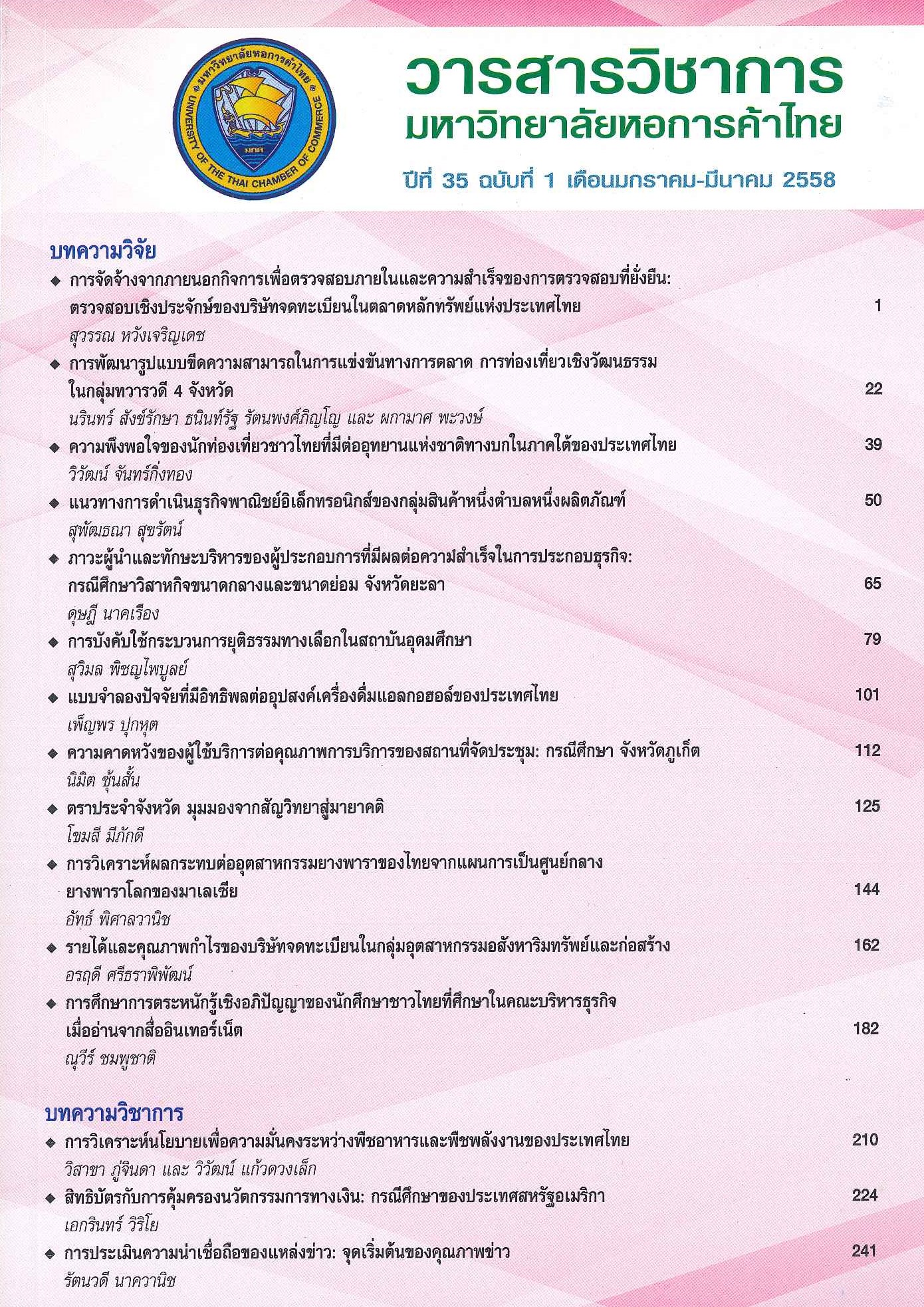Sources Reliability Evaluation: the Beginning of the News Quality
Main Article Content
Abstract
This article studies how reporters evaluate the credibility of news sources, drawn from information gathered from literature and interviews with political beat reporters. The study showed that reliability is the most important factor in the selection of news sources. Reporters' observation is the most credible source, followed by documentary Source and human source respectively. Four dimensions on which reporters based their evaluation of human source's credibility were trustworthiness ,appearance, motivation and status- position. The guidelines to evaluate the credibility of news sources are described by the news source as follows
1. To determine whether the sources were reliable, reporters asked themselves about how this person knew this information, whether the record of this source was reliable, whether this source had any bias or confict of interest that would compromise the integrity of what he/ she said, whether this information was available from other sources and could be verified.
2. To determine whether documentary source was reliable ,reporter was to rely on primary documentary source rather than secondary documentary source .
3. To determine whether online sources were reliable, reporter used crowd sourcing and cross-referencing to verify social media sources. The study also found that reporters rated sources in different level based on their intuition as a part of the process of deciding whether sources were reliable. Reporters must report quickly, although the process could not be done within a short time. Under such restrictions, reporters tried to avoid the use of the political overtones language.
Article Details

This work is licensed under a Creative Commons Attribution-NonCommercial-NoDerivatives 4.0 International License.
ลิขสิทธิ์ของบทความ
ผลงานที่ได้รับการตีพิมพ์ถือเป็นลิขสิทธิ์ของมหาวิทยาลัยหอการค้าไทย ห้ามมิให้นำเนื้อหา ทัศนะ หรือข้อคิดเห็นใด ๆ ของผลงานไปทำซ้ำ ดัดแปลง หรือเผยแพร่ ไม่ว่าทั้งหมดหรือบางส่วนโดยไม่ได้รับอนุญาตเป็นลายลักษณ์อักษรจากมหาวิทยาลัยหอการค้าไทยก่อน
References
Thailand's three Southern Border Provinces. Bangkok: Pab Pim. (in Thai).
สถาบันวิชาการสื่อสาธารณะ. 2556. คู่มือการรายงานข่าวเพื่อสลายความขัดแย้ง: กรณีปัญหาความไม่สงบในสามจังหวัดชายแดน
ใต้. กรุงเทพมหานคร: ภาพพิมพ์.
Burn, Lynette Sheridan. 2013. Understanding Journalism. 2nd ed. Los Angeles: CA: Sage. Verification of the Reliability of Sources [On line]. Available: https://jn8107.wikispaces.com/Verifying+Sources
Chaikasem, Napacharote. 2014, February 10. Channel 3 TV. Reporter. Interview. (in Thai).
นภจรส ใจเกษม. 10 กุมภาพันธ์ 2557. ผู้สื่อข่าวสถานีโทรทัศน์ช่อง 3. สัมภาษณ์.
Changyai, Boomlert, Wannaperd, Sumed and Boontanom, Supad. 1983. Investigative new Reporting Guideline: Experience and Interview Techniques. Bangkok: the Institute of the Development of Thai Newspaper. Asia Foundation and the Henry R. Luce. Foundation. (in Thai).
บุญเลิศ ช้างใหญ่, สุเมธ วรรณพฤกษ์ และ สุพัตร์ บุญถนอม. 2536. คู่มือการรายงานข่าวเชิงสืบสวนประสบการณ์นักข่าว ชุดเทคนิค
การสัมภาษณ์ และการทำข่าวเชิงสืบสวน กรุงเทพมหานคร: สถาบันพัฒนาการหนังสือพิมพ์แห่งประเทศไทย มูลนิธิอาเซียนและมูลนิธิเฮนรีอาร์ลูซ.
Chitpong, Naris. 2014, March 18. Manager Radio Reporter. Interview. (in Thai).
นริศ จิตพงษ์. 18 มีนาคม 2557. ผู้สื่อข่าววิทยุผู้จัดการ . สัมภาษณ์.
Christians, C.G, Rotzoll, K.B., and Fackler, M. 1983. Media Ethics. New York: Longman.
Dansker, Emill. 1980. "How Reporters Evaluate the Credibility of Their Sources." Newspaper Research Journal 1, 2: 40-45.
Eamngarmsup, Roongnapa. "Human Source Utilization of Daily Newspaper Reporters." Master's Thesis. Department of Journalism. Chulalongkorn University. (in Thai).
รุ่งนภา เอี่ยมงามทรัพย์. 2545. "การใช้แหล่งข่าวบุคคล ของนักข่าวหนังสือพิมพ์รายวัน." วิทยานิพนธ์ปริญญานิเทศศาสตรมหาบัณฑิต
สาขาวิชาวารสารสนเทศ จุฬาลงกรณ์มหาวิทยาลัย.
Franklin, Bob and Carlson, Matt. 2011. Journalist, Sources, and Credibility. New York: Routledge.
Harrower, Tim. 2013. Inside Reporting: a Practical Guide to the Craft of Journalism. 3rd ed. New York: McGraw- Hill.
Joann, Byrd. 2011. A Guide for Evaluating Sources [On line]. Available: https://www.poynter.org/latest-news/everyday-ethics/talk-about-ethics
Kulrachote, Chantralaporn. 2014, March 20. Matichon Reporter. Interview. (in Thai).
จันทรพร กุลโชติ. 20 มีนาคม 2557. ผู้สื่อข่าวหนังสือพิมพ์มติชน. สัมภาษณ์.
Nakwanit, Rattanawadee. "News Sources." in e-Learning CA 204 Introduction to News Reporting. Bangkok: School of Communication Arts. The University of the Thai Chamber of Commerce. (in Thai).
รัตนวดี นาควานิช. 2556. "แหล่งข่าว." ใน บทเรียน e-learning วิชา CA 204 การสื่อข่าวและ เขียนข่าวเบื้องตัน. กรุงเทพมหานคร:
คณะนิเทศศาสตร์ มหาวิทยาลัยหอการค้าไทย.
Parichat, Sommai. Investigative News Reporting: Thai Newspaper. 3rd ed. Bangkok: Saitan Publisher. (in Thai).
สมหมาย ปาริจฉัตต์. 2543. ข่าวเจาะ เจาะข่าวหนังสือพิมพ์ไทย. พิมพ์ครั้งท่ 3. กรุงเทพมหานคร: สายธาร.
Pongpapad, Judesawat. 2014, March 20. Military Radio Reporter. Interview. (in Thai).
ยศวัฒน์ พงษ์ประภาส . 20 มีนาคม 2557. ผู้สื่อข่าวศูนย์ข่าวกองทัพบก. สัมภาษณ์
Pongpipatwattana, Sataporn. 2014, February 10. Thai PBS. Reporter. Interview. (in Thai).
สถาพร พงษ์พิพัฒน์วัฒนา. 10 กุมภาพันธ์ 2557. ผู้สื่อข่าวสถานีโทรทัศน์ช่อง Thai PBS. สัมภาษณ์.
Pornwasin, Asina. 2014, July 22. Social Media Editor Nation Multimedia Group. Interview. (in Thai).
อศินา พรวศิน. 22 กรกฎาคม 2556. บรรณาธิการ social media เครือเนชั่น. สัมภาษณ์.
Shoemaker, P.J and Reese, S.D.1996. Mediating the Message: Theories of Influences on Mass Media Content. 2nd ed. New York: Longman.
Wanrigo, Prachan. 2004. "Chapter 4: News Sources Evaluation." in Introduction to Journalism, Chapter 1-6. pp. 25-30. Nonthaburi: Sukhothaithammathirat. (in Thai).
ประชัน วัลลิโก. 2547. "หน่วยที่ 4: การประเมินแหล่งข่าว." ใน ประมวลสาระชุดวิชา การหาข่าวเบื้องต้น. หน่วยที่ 1-6. หน้า 25-30. นนทบุรี: มหาวิทยาลัยสุโขทัยธรรมาธิราช.


